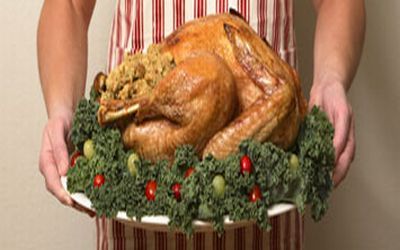CDC Offers Tips for Safe Holiday Meal Preparation

Whether you're a seasoned chef or a novice preparing your first holiday meal, make sure you know the safest ways to thaw, prepare, stuff and cook your turkey. Holidays are times we share the kitchen with family and friends. Make it a goal this year to also share good food safety practices. The Centers for Disease Control and Prevention (CDC) is a partner with the United States Department of Agriculture (USDA), Food Safety and Inspection Service (FSIS), which is responsible for the safety of meat and poultry. Here are simple tips that all cooks in the kitchen can follow this holiday season for cooking a delicious and safely prepared turkey.
Turkey Basics: Safely Thaw, Prepare, Stuff, and Cook
When preparing a turkey, be aware of the four main safety issues: thawing, preparing, stuffing, and cooking to adequate temperature.
Safe Thawing
Thawing turkeys must be kept at a safe temperature. The "danger zone" is between 40 and 140°F the temperature range where foodborne bacteria multiply rapidly. While frozen, a turkey is safe indefinitely, but as soon as it begins to thaw, bacteria that may have been present before freezing can begin to grow again, if it is in the "danger zone." There are three safe ways to thaw food: in the refrigerator, in cold water, and in a microwave oven.
Safe Preparation
Bacteria present on raw poultry can contaminate your hands, utensils, and work surfaces as you prepare the turkey. If these areas are not cleaned thoroughly before working with other foods, bacteria from the raw poultry can then be transferred to other foods. After working with raw poultry, always wash your hands, utensils, and work surfaces before they touch other foods.
Safe Stuffing
For optimal safety and uniform doneness, cook the stuffing outside the turkey in a casserole dish. However, if you place stuffing inside the turkey, do so just before cooking, and use a food thermometer. Make sure the center of the stuffing reaches a safe minimum internal temperature of 165°F. Bacteria can survive in stuffing that has not reached 165°F, possibly resulting in foodborne illness. Follow the FSIS' steps to safely prepare, cook, remove, and refrigerate stuffing; Spanish language instructions are available.
Safe Cooking
Set the oven temperature no lower than 325°F and be sure the turkey is completely thawed. Place turkey breast-side up on a flat wire rack in a shallow roasting pan 2 to 2-1/2 inches deep. Check the internal temperature at the center of the stuffing and meaty portion of the breast, thigh, and wing joint using a food thermometer. Cooking times will vary. The food thermometer must reach a safe minimum internal temperature of 165°F. Let the turkey stand 20 minutes before removing all stuffing from the cavity and carving the meat.
From the Derby to the Decontam Room: Leadership Lessons for Sterile Processing
April 27th 2025Elizabeth (Betty) Casey, MSN, RN, CNOR, CRCST, CHL, is the SVP of Operations and Chief Nursing Officer at Surgical Solutions in Overland, Kansas. This SPD leader reframes preparation, unpredictability, and teamwork by comparing surgical services to the Kentucky Derby to reenergize sterile processing professionals and inspire systemic change.
Show, Tell, Teach: Elevating EVS Training Through Cognitive Science and Performance Coaching
April 25th 2025Training EVS workers for hygiene excellence demands more than manuals—it requires active engagement, motor skills coaching, and teach-back techniques to reduce HAIs and improve patient outcomes.
The Rise of Disposable Products in Health Care Cleaning and Linens
April 25th 2025Health care-associated infections are driving a shift toward disposable microfiber cloths, mop pads, and curtains—offering infection prevention, regulatory compliance, and operational efficiency in one-time-use solutions.
Phage Therapy’s Future: Tackling Antimicrobial Resistance With Precision Viruses
April 24th 2025Bacteriophage therapy presents a promising alternative to antibiotics, especially as antimicrobial resistance continues to increase. Dr. Ran Nir-Paz discusses its potential, challenges, and future applications in this technology.